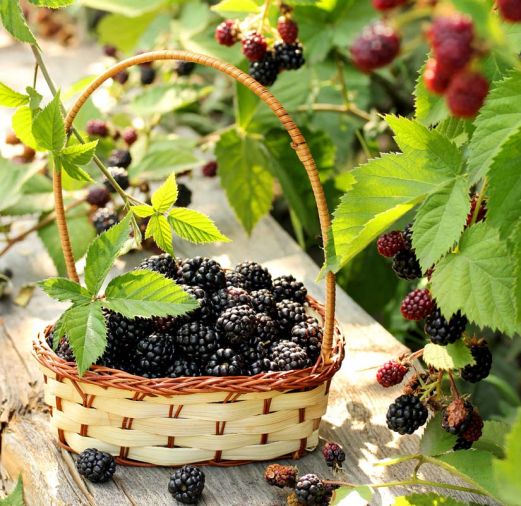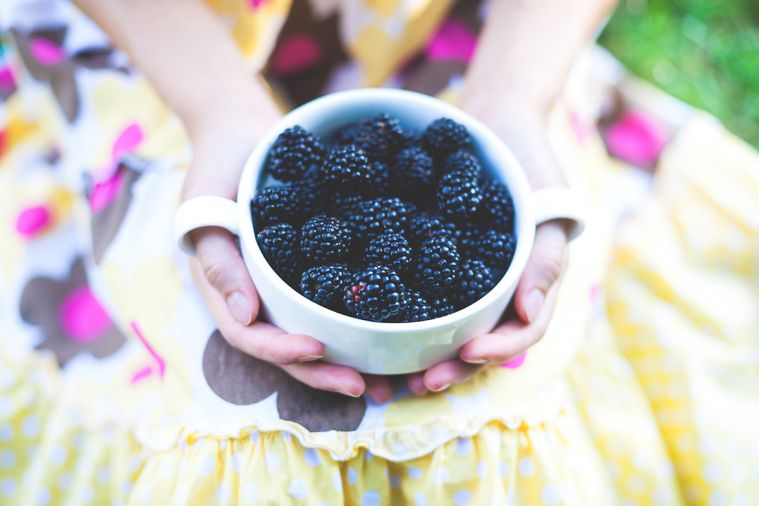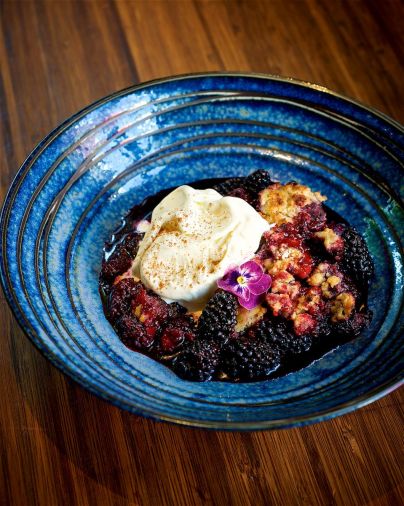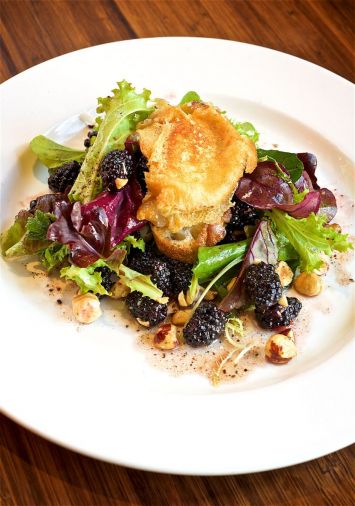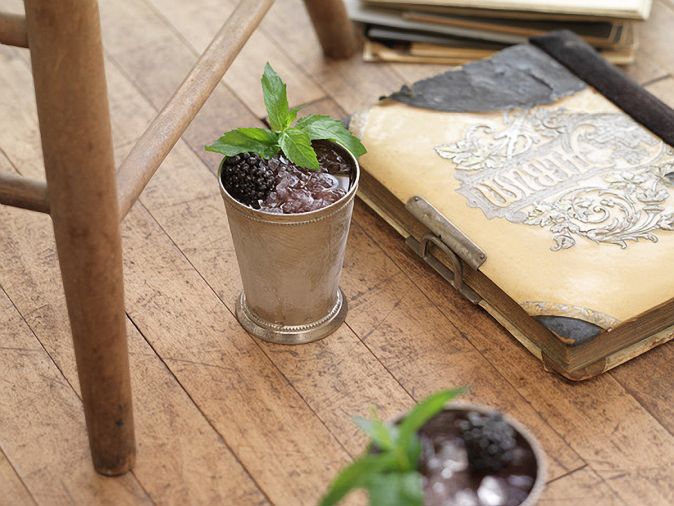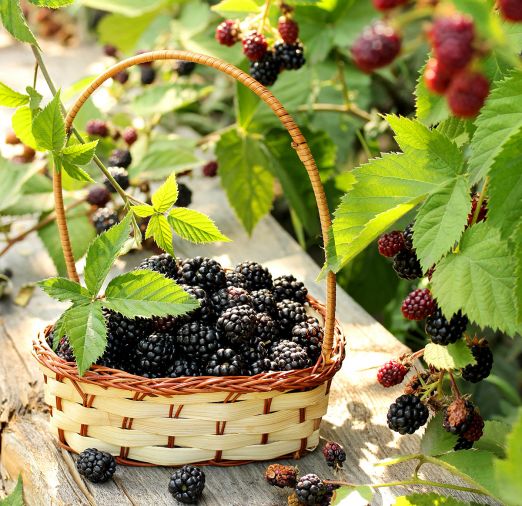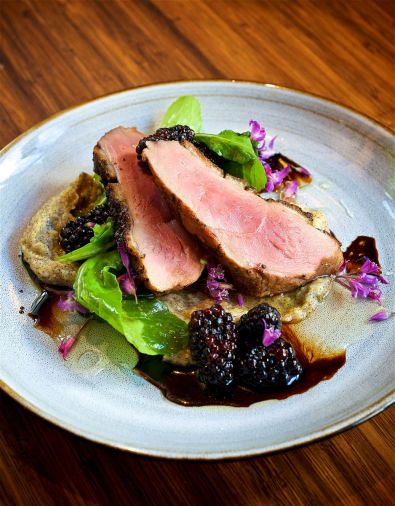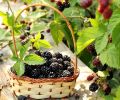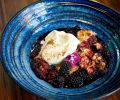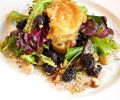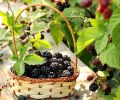Oregonians are no strangers to berries. Our state grows them all—blueberries, blackberries, raspberries, strawberries, tayberries, loganberries, cranberries, boysenberries, ollalieberries—a glittering rainbow of sweet, delicious summertime treats. But there’s something special about the Marionberry, that long, dusky, extra-juicy blackberry that makes a brief, show-stopping appearance at grocery stores, farmer’s markets, roadside stands, and backyard bramble patches in midsummer.
Marionberry’s history goes back to the middle of the 20th century, when a USDA plant breeder named George Waldo started to work with Oregon State University to develop a better, more productive blackberry variety for the Northwest. His work—like the work of berry breeders before and after him—hinged on the loganberry, a berry that had been produced when a horticulturalist and amateur backyard fruit breeder named James Harvey Logan somewhat inadvertently created a cross between two different cane berries: a blackberry (Rubus ursinus) and a raspberry (Rubus idaeus).
The resulting berry was highly productive, with strong canes, a robust growth habit, and big, juicy berries—although sometimes, they could have a slightly bitter aftertaste. However, the discovery that blackberry/raspberry crosses were not only viable, but often an improvement over the original plants, ushered in a new era of breeding and experimentation, with projects popping up all over the country in an effort to breed new, regionally adapted berry varieties—including right here in Oregon. “At the time, the Northwest industry was new,” says Chad Finn, a USDA-ARS plant breeder specializing in small fruits. “Olallieberry was the standard California berry, but it never did as well up here. So what [George] was doing was developing more commercially viable cultivars for the Northwest.”
As part of that project, George crossed two existing berries: the Chehalem blackberry (itself a cross George had previously made between the Santiam berry and the ubiquitous Himalayan blackberry, that rugged, robust variety that fills ditches around the Northwest) and the Olallieberry, the loganberry/youngberry cross that had taken the California industry by storm. One line of plants that resulted from that cross was vigorous, well adapted to Oregon’s climate, and productive—and, most importantly, startlingly delicious.
“The main thing about marionberries is the fruit quality,” says Chad. “More specifically, it’s the flavor.” And it’s true. Marionberries aren’t particularly large compared to the zaftig boysenberry or the gargantuan loganberry, they’re practically petite. The bushes are thorny, the berries are seedy, and the plants can be somewhat cold tender. But the eating experience of the marionberry is unmatched: the berries have a firm yet yielding texture, with an amazing wine-like flavor, good sweetness, and bright (but not overpowering) acidity. No wonder the Oregon Raspberry & Blackberry Commission calls them the “Cabernet of blackberries.”
Their great flavor and homegrown success story have helped marionberries develop a cult following, especially here in Oregon. Perhaps that’s because we’re among the only people in the nation to experience the pleasure of eating marionberries fresh, since the fruits are too soft to ship any significant distance. Perhaps it’s a kind of hometown pride, since marionberries, born and bred in state, belong to that exclusive native Oregonian club. They’re even named after Marion County in the Willamette Valley, where they were extensively tested. Or perhaps it’s simply because our marionberries are, without a doubt, the best, perfectly adapted to our mild winters and warm summers. “It’s one of those things, the best blackberry grower in Washington can’t do as good a job as the best in Oregon,” says Chad.
No matter the reason, marionberries are now ubiquitous in Oregon. Each year, we grow 26 million pounds of the dark, dusky fruit, 95% of which is frozen. Marionberries find their way into a huge range of dishes, from classic berry haunts like pies and jams to more innovative applications like barbcue sauce, beers, ciders, and spirits. They even represent us abroad, the horticultural equivalent of a cultural ambassador. Recently, chef Gregory Gourdet of Departure Lounge took a suitcase full of marionberry jam to Paris at the request of a French chef who wanted to taste something “uniquely Oregon.”
Gregory isn’t the only Oregon chef who wants in on the marionberry action. During the height of summer, you can spot marionberries on menus all over town, from the toniest fine-dining restaurants all the way to the Burgerville drive-through, where they’re swirled into a seasonal milkshake that makes for a stellar Saturday afternoon pick-me-up.
At Q Restaurant & Bar, executive chef Annie Cuggino uses Oregon berries, including marionberries, all summer long, where they pop up on every section of the menu, from cocktails to dessert. “All the berries, really, are so special,” says Annie. “It’s such a fleeting season that it makes them more cherished. And everybody likes berries.”
Marionberries’ moderate sugar content and resonant flavor makes them a natural fit in savory dishes as well as sweet, contrasting well with rich meats like pork and duck and adding a vinous note to savory sauces. They’re also relied on to brighten up lighter dishes, adding color and succulence. One salad on Q’s summer menu pairs in-season berries with hazelnuts, mixed greens from Mizuna Garden Farm, and honey pepper vinaigrette topped with a crisped goat cheese crostini. Any berries that are too soft for salad or get crushed in transit are pureed and frozen, only to emerge later in the year as syrups for cocktails or a fruity ribbon swirled through ice cream, a sweet reminder of warmer times.
The inky marionberry is a fleeting pleasure—the season only lasts about a month, from July to August—but somehow that makes it all the sweeter, a reminder to slow down and savor the present moment. “We just celebrate the Marion when it’s here,” says Annie. “And when it’s gone, it’s gone.”
MARIONBERRY CRISP
Recipe by Exceutive Chef Annie Cuggino
Q RESTAURAUNT & BAR
www.q-portland.com
Makes 9 Servings
FRUIT FILLING
13 cups Marionberries
2 cups Sugar
Pinch of salt
½ cup Lemon juice
Zest of 1 lemon
3 Tbsp Flour
In a large bowl, toss all ingredients together until berries are coated evenly. Put berries in desired baking pan (suggested: 9x13) and smooth out until level.
CRISP TOPPING
3 cups Flour
1½ cups Sugar
1 tbsp Baking powder
3 Eggs
1 cup Butter, melted
1½ tsp Salt
Pinch of cinnamon
Whisk together flour, sugar, baking powder and salt very well in a medium sized bowl. Crack the three eggs directly into bowl and loosely mix together until dough is crumbly. Do not overmix, it should be lumpy and irregular.
TO BAKE
Add topping directly on top of berries and spread evenly. Melt butter and pour over the topping mixture, moistening as much of your flour as possible. Sprinkle with a little bit of cinnamon. Bake at 325 for 50 - 60 minutes or until crisp is golden brown and cooked through. Enjoy while hot with vanilla or buttermilk ice cream.
BUCHE SALAD
Recipe by Exceutive Chef Annie Cuggino
Q RESTAURAUNT & BAR
www.q-portland.com
Serves 4
4 ¼ inch slices of baguette
2 cups Marionberries
6 cups mixed Salad greens
6 oz Buche de Lucay cheese
½ cup Roasted Oregon hazelnuts (crushed)
Honey pepper vinaigrette
Extra virgin olive oil
Salt and Pepper
MAKE THE CROSTINI
Place baguette slices on a sheet pan and drizzle with extra virgin olive oil, salt and pepper. Bake until crispy and golden brown.
HONEY PEPPER VINAIGRETTE
(makes more than you need, saves for
a couple weeks.)
In a medium bowl combine:
½ cup Honey
½ bunch Thyme leaves
6 oz Currant vinegar
1 cup Red wine vinegar
½ cup Hazelnut oil
2 cups blend oil (we make this using a 3:1 ratio of canola oil to extra virgin olive oil)
2 Tbsp freshly ground black pepper
Salt to taste
ASSEMBLE THE SALAD
Slice the Buche de Lucay into rounds about ½ inch thick (or 3 oz). Cut each round crosswise to make half-circles. Put a small non-stick pan over medium-low heat. Brown cheese on both sides. It will form a nice crust. In a large bowl, toss the salad greens, the berries, and the honey pepper vinaigrette. Mix well. Distribute the salad onto plates, sprinkle with crushed roasted Oregon hazelnuts. Place one crostini on each salad and top with the cheese.
B.F.D.
(recipe by Q Restaurant & Bar)
1½ oz Rose City Vodka
¾ oz marionberry puree
½ oz mint simple syrup
½ oz lime juice
Cava (a dry, Spanish sparkling wine)
Mint sprigs for garnish
Collins glass
Strainer
In a cocktail shaker, pour in the Vodka, blackberry puree, simple syrup and then lime juice. Fill your shaker tin with ice, give it a few good shakes and then strain mixture into a Collins glass. Fill your glass with ice and the top the cocktail off with Cava. Garnish with a beautiful sprig of mint, drink and enjoy!
MARIONBERRY MINT JULEP
(recipe by Eastside Distlling)
www.eastsidedistilling.com
2 oz Marionberry Whiskey
Eastside Distilling
10 Fresh Mint Leaves
2 Marionberries
½ oz Simple Syrup
½ oz Lime Juice
Crushed Ice
Garnish with Marionberry and Mint
Muddle mint leaves and marionberries, combine all the ingredients, and pour into glass with crushed ice.
CRISPY DUCK BREAST WITH OREGON MARIONBERRIES
Recipe by Exceutive Chef Annie Cuggino
Q RESTAURAUNT & BAR
www.q-portland.com
Buckwheat polenta
Baby arugula
Oregon marionberries
Local honey
Aged balsamic vinegar
Brush the fish with a small amount of Olive oil, season with salt and pepper and cook on the grill until fully cooked. Squeeze fresh lemon juice on the fish. Place the fish in a serving dish and then top with the Olive caper relish. Sprinkle Jacobsen Sea Salt on top and garnish with micro greens and sliced radishes.
BUCKWHEAT POLENTA
1 cup Cornmeal (fine)
¼ cup Buckwheat flour
¼ cup Mascarpone
2 Tbsp Parmigiano reggiano
1 sprig Fresh sage
½ tbsp Minced garlic
¼ cup Minced shallot
Saute garlic and shallot in 2 tbsp butter.
Add 4 cups of water and boil with the sage. Whisk cornmeal into water in a steady stream. After a few minutes, the cornmeal will start to thicken. Turn heat down to low. Whisk in the buckwheat flour and cook mixture until very thick (about 15 minutes). With a rubber spatula, fold in mascarpone, parmigiano, salt and pepper. Pick out the sage and discard. Set polenta aside and keep warm while cooking the Duck.
FOR THE DUCK
Start one day before serving to let the duck marinate. Trim the duck breasts of any excess fat or gristle. Score the skin to allow the duck to fully absorb the herbs. Sprinkle the breasts with a few sprigs of herbs. Thyme, sage and rosemary all work well. Pick your favorite or use a little of each. Smash a few cloves of garlic and rub on duck. Season breasts with salt and freshly ground black pepper. Place in container add refrigerate for 24 hours.
TO COOK
Place duck on a medium heat grill or pan, skin side down. Cook slow and evenly so that the fat renders and the skin crisps without burning. When ¾ of the way done, flip the duck and finish cooking on the meat side. Cook to medium rare. Remove the duck from heat and let rest 3 -5 minutes before slicing.

